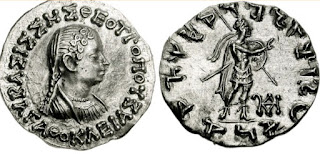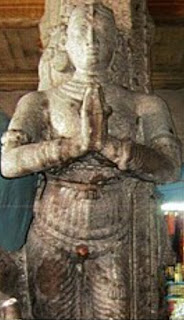There have been some extraordinary Indian Queens who deserve to be given greater importance in Indian history. They have been brave, fierce, powerful and prominent rulers who were stellar examples of legendary women power in Indian history. Their stories are immortalized on their coinage and need to be highlighted.
Queen Agathokleia. She was an Indo-Greek queen who ruled in parts of northern India in the 2nd century CE. She was amongst the first woman to rule a Hellenistic Kingdom. She seems to have associated herself with Athena, goddess of war that was the dynastic deity of the family of Menander. Most of her coins were struck with her son Strato I. In the civil wars after Menander's death, the Indo-Greek empire was divided, with Agathokleia and her younger son Strato I, maintaining themselves in the eastern territories of Gandhara and Punjab. As her son was too young to govern when he inherited the throne, she acted as regent for several years until Strato I came of age.
Queen Naganika. Amongst the earliest queens to have issued coins in her name lived around the 1st century BC, in Western India. This Satavahana queen was the wife of Satakarni I, the first major ruler of the Satavahana dynasty of the Deccan region. She was the ruler and the military commander of the Satavahana Empire. The inscription at Naneghat near Junnar commissioned by the queen around 75-30 BC, gives out the details of glory and the might of the king and the queen. The discovery of her coins help understanding one of the greatest empires of this period. The inscription also states how the matrimonial alliance of the queen who was the daughter of Maharathi King Tranakiya, ruler of parts of Maharashtra with Satakarni led to building of the great empire, from the earlier Satavahana rulers who controlled a small section of the present-day Andhra region.
Inscription at Naneghat
Rani Sugandha Devi. Her marriage to Shankaravarman (CE 883-902) of the Utpala dynasty catapulted him to an exalted political status since she belonged to a powerful family. She is documented to having accompanied her husband on military expeditions and was a force to reckon with. After Shankaravarman's death, she displayed sagacity and ruled the kingdom as a regent initially, and she ruled Kashmir from 905 to 907 AD, until she was dethroned. Her coinage is important corroborative evidence of her power and refers to her by the masculine epithet, Sri Sugandha Deva.
Rani Rudramadevi (1262-1289 AD). The legendary queen who ruled from Orugallu, the present-day Warangal, had no male siblings and was brought up like a "son" by her father Ganapathideva, and even assumed the male name of Rudradeva Maharaja. She wore male attire and took over the reign at the age of 14 years and brought stability to Kakatiya rule, won many battles, especially against the Yadavas of Devagiri, and kept the Pandyas and Cholas at bay. She began to rule conjointly with her father as co-regent from 1259 AD onwards and assumed full sovereignty in 1262-62 AD but was crowned queen in 1269 AD after the death of her father.
Queen Rudramadevi
Two sequential sculptures found at Bollikunta village in Warangal District of Telangana show (as per Archeological Survey of India) that she lost her life fighting against Ambadeva, of Valluru Kingdom. around 1272 AD.

Rani Mangamma ruled Madurai Nayak Kimgdom for 15 years from 1689 to 1704 AD. She was a courtesan from Tiruvellore near Chennai. She was very beautiful and talented. Her name was Kanka. She reached Thanjavur in search of a career, but Vijaraghava of Thanjavur intended to take her to his harem and so she fled. She married Chokkanatha Nayaka of Madurai. Mangamma alias Kanaka survived her husband and her son, and after the demise of the later in 1689 ruled the kingdom till 1707 as a regent during the minor age of her grandson. During a critical phase, while facing Aurangzeb on one side and the rulers of Mysore, Thanjavur, Ramnathapuram and Travancore on the other side, she very shrewdly approved the supremacy of the Mughal emperor and agreed to pay him an annual tribute for the sake of her kingdom. She fought a number of wars and was compared to Cleopatra in beauty. She was however thrown into prison by her grandson's coteries, and she died there.
Queen Calliope was an Indo-Greek queen. She was the wife of a Eucratid dynasty King, called Hermaeus, who ruled the Paropamisade in the Hindu-Kush region around 90 BCE. Queen Calliope appears on the coinage of her husband. The silver coin depicts the conjoined bust of both king and queen. This coin was issued around 90-70 BCE. This coin depicts her authority as the joint sovereign over the kingdom.
Somalekha Devi / Somala Devi. (1110-1125 AD). The Queen of the Chauhan dynasty, her name appeared on the coins as the joint ruler with her husband and King Aiaya Raja. (Who established the city of Ajayameru, present day Ajmer). They were billion drachmas, and the reverse of these coins bore a crude horseman and the queen's name, 'Somala Devi' on the obverse. Even after the death of the queen, Somala Devi coinage continued. This indicated that she remained popular even after.





















Awesome! Looking forward to your next!
ReplyDeleteAll your write ups are engrossing, so well researched and in detail, Rajeev! Wonderful effort and collection!
ReplyDelete